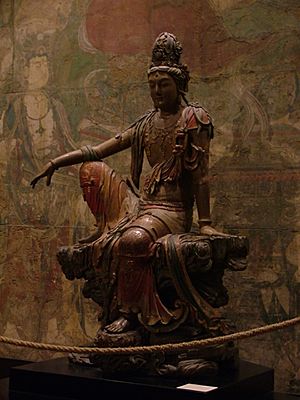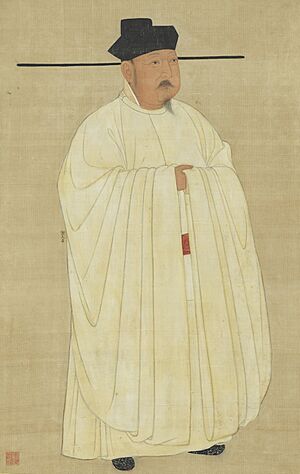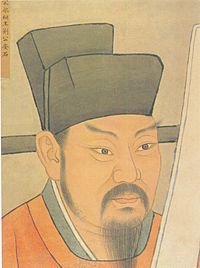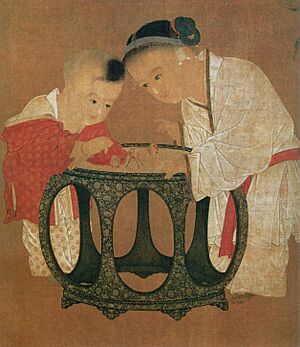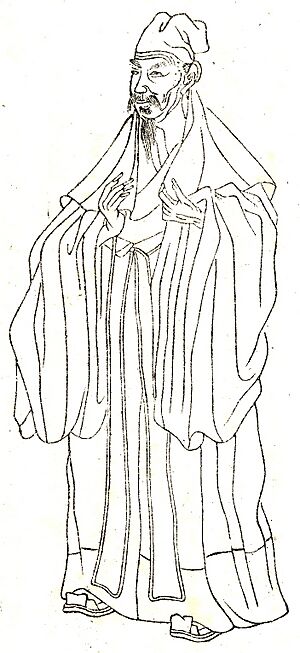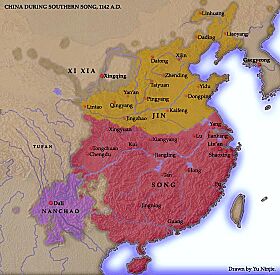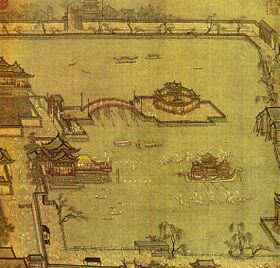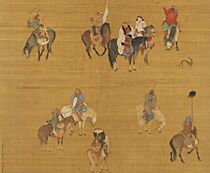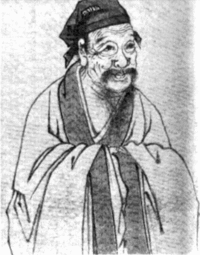History of the Song dynasty facts for kids
The Song dynasty (Chinese: 宋朝; pinyin: Sòng cháo; 960–1279) was an important imperial dynasty in China. It ruled most of China proper and southern China for over 300 years. Emperor Taizu of Song started the dynasty by taking the throne from the Later Zhou in 960. This ended the Five Dynasties and Ten Kingdoms period, a time of much fighting.
The Song period was a time of great Chinese inventions and new ideas in science and technology. Smart people like Shen Kuo and Su Song lived then. They also started using gunpowder weapons in new ways. However, it was also a time of political trouble and wars. Different groups at court often disagreed, which slowed down progress. The Song Empire often fought battles with the Tangut-led Western Xia dynasty and the Khitan-led Liao dynasty to the north.
In 1127, the Song Empire lost a big war against the Jurchen-led Jin dynasty from the north. This event is called the Jingkang Incident. The Song court had to leave their capital, Kaifeng, and move south to Hangzhou. This split the Song dynasty into two parts: the Northern Song (960–1127) and the Southern Song (1127–1279). The Southern Song built a new navy to fight the Jin. They even fought the Jin alongside the Mongols. But in the end, the Mongol-led Yuan dynasty defeated the Song dynasty at the Battle of Yamen in 1279.
Contents
- How the Song Dynasty Began
- Relations with Liao and Western Xia
- Relations with Đại Việt and Border Conflict
- Political Groups and Reforms
- Jurchen Invasions and the Southern Song
- China's First Standing Navy
- Defeating the Jin Invasion in 1161
- Rise of the Mongols
- Mongol Invasion and End of the Song Dynasty
- Historical Writings
- See also
How the Song Dynasty Began
The Later Zhou was the last of the Five Dynasties that ruled northern China after the Tang dynasty fell in 907. A general named Zhao Kuangyin, who later became Emperor Taizu (ruled 960–976), took the throne in 960. He had the support of his military commanders. This is how the Song dynasty began.
Emperor Taizu's main goal was to unite China again after 50 years of being divided. He conquered many smaller kingdoms in the south, like Nanping and Southern Tang. He also fought in the north. The early Song army was very strong, with skilled officers. They used clever tactics, like building floating pontoon bridges to move supplies. In one battle in 971, Song forces used many arrows from crossbows to defeat the war elephants of the Southern Han. This was the last time elephants were a regular part of a Chinese army.
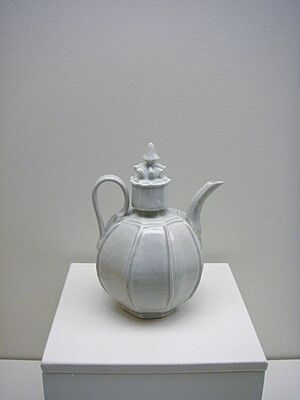

By 978, the Song had united the south. They then turned north and defeated the Northern Han in 979. However, they could not take the Sixteen Prefectures from the Liao state. The Song dynasty was strong against the Liao dynasty. They also won important battles against the Western Xia (who were later conquered by the Mongols).
After uniting China, Emperor Taizu invited his military officers to a banquet. He talked about the risk of a military takeover, like what happened in the Five Dynasties era. His officers said they would never do that. Taizu then suggested they give up their military power and retire to nice lands. He said they could live in peace and their families could marry into the imperial family. The next day, the commanders resigned, saying they were sick. The emperor gave them gifts and high official jobs.
Emperor Taizu created a strong central government. Civilian scholar-officials, chosen through tough exams, replaced military governors. This gave the emperor more power than in earlier dynasties. In the early 11th century, about 30,000 men took the exams each year. This number grew to 400,000 by the 13th century. However, only a small number were accepted into government jobs, making the exams very competitive.
Emperor Taizu also improved map-making. In 971, he ordered a huge project to update all maps. This work was finished in 1010 and had 1566 chapters. These maps helped the government manage provinces, collect taxes, and deal with bandits.
Taizu was also interested in science and technology. He supported projects like Zhang Sixun's hydraulic-powered armillary sphere, which used liquid mercury to tell time. He was open-minded, even appointing an Arab Muslim named Ma Yize as the chief astronomer. The Song court also had many rules for receiving envoys from other countries like Goryeo (Korea). They also sent their own envoys abroad, like Wang Yande, who visited the Uyghur-Turkic city of Gaochang in 981.
Relations with Liao and Western Xia
The Great Ditch and Peace Treaty
At first, relations between the Song and Liao (led by the Khitans) were mostly peaceful. They started exchanging envoys in 974. However, in 979, the Song attacked the Northern Han, which the Liao protected. The Song won, but then they marched towards the Liao Southern Capital (modern Beijing) and were defeated. This loss hurt the reputation of Emperor Taizong of Song (ruled 976–997).
Relations stayed tense. In 986, the Song sent three armies against the Liao but were pushed back. From 993 to 1004, the Song built a 'Great Ditch' in northern Hebei province. This was a series of canals to block Liao cavalry. The Liao saw this as a threat. In 999, the Liao began yearly attacks, trying to capture the Guannan region.
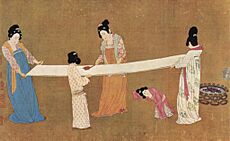
In 1004, Liao forces marched deep into Song territory, camping near the Song capital, Kaifeng. But their forces were spread too thin, and the 'Great Ditch' made it hard for them to escape. The Liao asked for a truce. This led to the Treaty of Shanyuan, signed in 1005. It set the borders as they were before the conflict. The Song had to pay yearly tribute to the Liao: silver and silk. Even with increases later, this tribute did not harm the Song economy. Much of the silver returned to China because the Song exported many goods to the Liao.
The Song had peaceful relations with the Liao until 1125. They sent skilled ambassadors like Su Song to keep the peace. The Song also prepared for war, increasing their army to a million soldiers by 1022. However, the military cost three-quarters of the state's tax money, while the tribute to Liao was only a small percentage.
Fighting and Talking in the Northwest
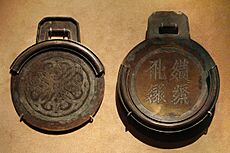
The Song first fought the Tanguts of the Western Xia dynasty in the 980s. The Tanguts, under Li Deming, attacked the Song but later sought peace, which brought economic benefits.
In 1034, a Tangut prince who had joined the Song raided Xia territory. The Tanguts, led by Li Yuanhao, fought back. Li Yuanhao later released captured Song soldiers and restored relations. He proclaimed himself the first emperor of Western Xia in 1038. He sent an envoy to the Song capital to gain recognition for his new title and stop paying tribute. The Xia then attacked Song borders. The Song closed their border markets and offered a reward for capturing Emperor Jingzong. Although Jingzong won early battles, he gained no new land by the end of the war in 1044. Both sides lost many soldiers. Jingzong also agreed to call himself an inferior subject when speaking to the Song emperor. The war was expensive, and the Song had to raise taxes by 50% in some areas.
In 1067, Emperor Shenzong of Song came to power. He wanted to reclaim territories he felt belonged to China. He shut down all trade markets with Western Xia to hurt their economy. The scientist Shen Kuo (1031–1095) was sent to defend against Tangut invasions. He successfully defended his position. However, he was later removed from office due to political reasons.
When Empress Dowager Gao died in 1093, Emperor Zhezong of Song stopped talks with the Tanguts. This led to more fighting. In 1099, the Song launched a campaign into Xining and Haidong, taking land from the Tibetan Gusiluo regime. By 1116, the Song had taken all of this territory, making it their western border against Western Xia.
Relations with Đại Việt and Border Conflict
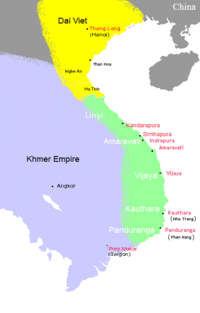
Historical Background
For about a thousand years, Chinese dynasties controlled northern Vietnam. Vietnam gained independence in 905 when a local noble, Khúc Thừa Dụ, became governor. In 938, Vietnamese general Ngô Quyền defeated the Southern Han state, ending Chinese rule. In 939, he started the Ngô dynasty. In 968, Duke Đinh Bộ Lĩnh united northern Vietnam and renamed his kingdom Đại Cồ Việt. Emperor Taizong of Song recognized Đại Cồ Việt's independence in 973, with a formal tribute relationship.
In 980, when Vietnam was unstable, the Chinese Emperor sent 40,000 soldiers to invade. But they were defeated by general Lê Hoàn in 981. Lê Hoàn became the new king and was also recognized by the Chinese Empire. His son, Lê Long Đĩnh, continued sending tribute to Song China. He also brought many Buddhist and Taoist books to Vietnam and had them translated. Relations between Song China and Vietnam remained peaceful.
In 1009, Lý Công Uẩn became the new Vietnamese ruler, starting the Lý dynasty. Song China continued to recognize the Lý monarchs. Vietnamese envoys sent gifts like horses and jades to China and received books and clothes in return. In 1014, Đại Việt had a border conflict with the Dali kingdom. The Vietnamese king's envoy brought 100 horses captured from Dali to the Song court as gifts.
Later, a rebel named Nong Zhigao tried to create his own kingdom on the border. This caused trouble for the Song. The Song invaded Nong Zhigao's forces in the 1050s. This led to the Song taking some border areas and a conflict with the Lý dynasty from 1075 to 1077. The Song wanted to gain economic benefits from these border areas. The Lý dynasty wanted to strengthen their control over their lands. After the conflict, both sides agreed on new borders that mostly remain the same today.
Border Tensions
The Vietnamese court did not get involved when the Song general Di Qing crushed Nong Zhigao's rebellion in 1053. For the next 20 years, Vietnam watched as the Song expanded. More Chinese settlers moved into areas that Vietnam used for natural resources.
A Song official, Wang Han, worried about Nong Zhigao's relatives raiding the border. He visited Nong Zhigao's son and suggested they remain outside China to act as loyal border guards. However, the Song government rejected his idea. They made the Nong communities official dependents of Song authority. In 1062, Nong Tông Đán's request to join the Song Empire was granted. In 1059, the Vietnamese ruler Lý Thánh Tông reorganized his northern border units and raised new militias. This strengthened his kingdom during a conflict with Champa.
In 1060, local groups under a Vietnamese governor raided the Song border for cattle and recruits. They took a Song military leader hostage. Song troops were sent to rescue him but failed. The Song court appointed Yu Jing as a new military commissioner. He also sent an agent to Champa to ask for help against the Song's enemies.
Tribute and Court Secrets
The Vietnamese court found out about the Song's secret plan to ally with Champa. While Vietnam sent a group to Yongzhou to thank the Song for stopping local rebellions, they also gathered information about the Champa alliance and Song military strength. Two Vietnamese envoys offered tribute to Emperor Renzong's court in Kaifeng in 1063, including nine tamed elephants. When Emperor Renzong died, Vietnamese envoys congratulated the new emperor, Emperor Yingzong of Song. News arrived that the Vietnamese governor Thàn Thiệu Thái had raided Song territory again. Yingzong left the defense to local forces and called Thàn Thiệu Thái "reckless and mad" to avoid blaming the Lý court.
A minor Song official reported in 1065 that Nong Tông Đán had switched loyalty to Lý. Emperor Yingzong, who was described as "mentally weak," only gave Nong Tông Đán new titles. The court did nothing to solve the problem. Nong Tông Đán later played a key role in the Lý–Song War of 1075–1077. The Song also gave official titles to other Vietnamese leaders, even though they were involved in rebellions against the Song.
Emperor Yingzong died in 1067, and Emperor Shenzong of Song took over. He was more careful with Vietnamese delegations. He sent many gifts to the Lý court and gave the Vietnamese ruler, Lý Thánh Tông, the official title "King of the Southern Pacified Region" in 1067. Shenzong also recognized Nong Tông Đán's relative, Nong Trí Hội, as the Nong clan leader.
Border Policy and War
Under Emperor Shenzong, Chancellor Wang Anshi introduced new policies. These policies increased central control over border areas, boosted militia activity, and sent more troops and war horses to the frontiers, including the border with Đại Việt. Wang also sought loyal people in border regions to help gather local resources for the state. Officials at court debated Wang's policies. Even in Đại Việt, a high officer named Lý Thường Kiệt publicly said that Wang's policies were meant to take their border lands. Tensions between Song and Lý were very high.
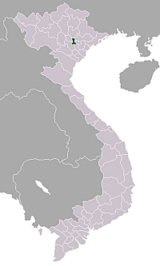
In 1075, a chieftain named Lưu Ký attacked Yongzhou, but a Vietnamese officer working for the Song pushed him back. Shenzong then tried to make an alliance with five clans in northern Guangnan. He ordered that all merchants stop trading with Đại Việt. This increased hostility and made the Vietnamese court, under Lý Nhân Tông, prepare for war.
In November 1075, Nong Tông Đản entered Song territory in Guangxi. A Vietnamese naval fleet led by Lý Thường Kiệt captured Qinzhou and Lianzhou. Lý Thường Kiệt told the local Chinese people that he was only catching a rebel who had hidden in China. In early 1076, Thường Kiệt and Nong Tông Đản defeated the Song militia of Yongzhou. They killed the Governor-General of Guangnan West Circuit. After a 42-day siege, Yongzhou was destroyed. When Song forces tried to fight back, the Vietnamese retreated with their war spoils and thousands of prisoners.
Lý Thường Kiệt had fought a war with the Cham in 1069. In 1076, Song asked the Khmer Empire and Champa to go to war again. At the same time, the Song commander Guo Kui led about 100,000 men against Dai Viet. The Song quickly took back Quảng Nguyên and captured Lưu Ký. By 1077, the Song had destroyed two more Vietnamese armies and marched towards their capital, Thăng Long (modern Hanoi). Song forces stopped at the Nhu Nguyệt River, where Lý Thường Kiệt had built defenses. Song forces broke through and their cavalry got very close to the capital. The Vietnamese fought back and pushed the Song across the river. Lý Thường Kiệt also launched an attack, but lost two Vietnamese princes. Chinese sources say that the "tropical climate and rampant disease" weakened the Song army. The Vietnamese court feared a long war so close to their capital. In 1078, China defeated Đại Việt and took several districts that are now part of Cao Bằng Province.
As a result, Thường Kiệt offered peace to the Song. The Song commander Guo Kui agreed to pull back his troops. But he kept five disputed regions. In 1082, after a long time of no contact, King Lý Nhân Tông of Đại Việt returned Yong, Qin, and Lian prefectures to Song. He also returned their prisoners of war. In return, Song gave up control of four prefectures and a county of Đại Việt. More talks happened in 1084, where the borders were finally set between Quảng Nguyên and Guihua prefectures.
After 1082
Relations between Vietnam and Song China were generally peaceful until the Mongol conquest. In 1125, a Vietnamese envoy brought gifts to the Song capital, Kaifeng. Soon after, the Jurchen Jin dynasty invaded northern China and besieged Kaifeng. This was the Jingkang incident. A Vietnamese prince in the group survived and sought refuge in Goryeo (Korea).
19 years later, the Song dynasty reorganized itself in the south as the Southern Song dynasty. The Vietnamese king Lý Anh Tông sent a new envoy to Song China, giving gifts of gold, silver, and ivory. In 1164, Emperor Xiaozong of Song officially recognized Vietnam as Annam. He called the Vietnamese rulers king of Annam. This Chinese name for Vietnamese monarchs continued until 1804.
There were no more tribute missions from Vietnam to China until the Trần dynasty took over from the Lý in 1225. In 1229, the Trần ruler Trần Thái Tông sent a diplomatic mission to Song China and was recognized as king of Annam. However, after the first Mongol invasion in 1258, Đại Việt ended all relations with the Song dynasty.
Political Groups and Reforms
After students passed the difficult Imperial Exams, they became officials. But they often disagreed with each other. Getting a higher job or more honors was uncertain. Young officials often needed older, higher-ranking officials to recommend them. Once an official reached the top levels of government, they would compete to influence the emperor's decisions. Officials with different ideas often formed groups to support each other and try to convince the emperor.
These political groups first appeared in the 1040s. The unsuccessful war with the Tanguts and growing economic problems led to the first reform movement. This was the Qingli Reforms started by Fan Zhongyan (989–1052). Fan was a good military leader, but as a minister, he was an idealist. He once said a good official should "worry about the world's troubles first and enjoy its pleasures last." When Fan became chancellor, many older, conservative officials opposed him. They did not like his ideas for changing the recruitment system, giving more pay to local officials to stop corruption, and choosing officials based on their intelligence. His reforms were canceled within a year because many older officials did not want changes that would affect their comfortable jobs.
After Fan Zhongyan, there was Chancellor Wang Anshi (1021–1086). The new 19-year-old Emperor Shenzong (ruled 1067–1085) liked Wang Anshi right away. Wang had written a long letter criticizing the state schools and the exam system. With Wang as his new chancellor, the emperor quickly started Wang's New Policies. These policies caused strong reactions from conservative officials. Along with a community-based law enforcement system, the New Policies included:
- Low-cost loans for farmers and replacing forced labor with a tax. Wang hoped this would help the economy and the state.
- Government control over tea, salt, and wine to increase state money.
- A new land survey system to correctly assess land taxes.
- Creating local militias to reduce the cost of the official army, which had grown very large.
- A new government office in 1073, the Directorate of Weapons, to oversee weapon making and quality.
- The Finance Planning Commission, created to speed up reforms.
- Removing the poetry requirement from the civil service exam to find people with more practical knowledge.
Wang Anshi also made his own writings on Confucian classics required reading for students taking state exams. These reforms were too much for some officials. There were many disagreements about how to run the government, and many personal interests were at stake. The growing conservative group against Wang Anshi called him unintelligent. Wang did not let ministers who opposed his reforms stay at court. He gathered loyal ministers, known as the New Policies Group. He had strong supporters like the scientist Shen Kuo. Officials who blocked Wang's reforms were often sent to lower jobs or exiled. For example, the famous poet and official Su Shi was arrested in 1079. He was questioned for five weeks and confessed that he had criticized the emperor in his poems. One of his poems seemed to criticize Wang Anshi's salt monopoly. After his confession, Su Shi was sent to Hubei Province. More than 30 of his friends were also punished for not reporting his poems.
Emperor Shenzong died suddenly in 1085. His successor, Emperor Zhezong of Song, was only 10 years old. His powerful grandmother became his regent. She disliked Wang's reforms and appointed more conservative officials. Her main ally was Sima Guang (1019–1086), who became the next Chancellor. Sima undid Wang's policies and treated the reformers the same way Wang had treated his opponents: by sending them to lower jobs or exiling them. However, some people still liked parts of the New Policies, like replacing forced labor with a tax.
When Emperor Zhezong's grandmother died in 1093, Zhezong quickly supported the reformers again. The conservatives were once more removed from power. When Zhezong died young, his younger brother Emperor Huizong of Song (ruled 1100–1125) became emperor. He also supported the reformers. Huizong banned Sima Guang's writings and honored Wang Anshi. He even had a statue of Wang placed in a Confucian temple. This cycle of political revenge continued, with reformers and conservatives constantly fighting. Huizong's successor, Emperor Gaozong of Song, again abolished the New Policies and favored conservative ministers.
Jurchen Invasions and the Southern Song
The Jingkang Incident
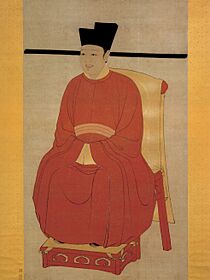
For centuries, the Song dynasty had a tense relationship with the Western Xia and the Khitan Liao dynasty. This changed when the Song allied with the Jurchens to destroy the Liao. Once the Liao were gone, the Jurchens turned on the Song. This led to the fall of the Northern Song and the start of the Southern Song.
During the reign of Huizong, the Jurchen tribe, who used to be under the Liao, rebelled. The Jurchens were known for their horses and their fighting skills. A leader named Wanyan Aguda (1068–1123) challenged Liao rule and started their own Jin (or 'Golden') dynasty in 1115. The Song government noticed this and decided to ally with the Jurchens against the Liao. They secretly formed the Alliance on the Sea. They agreed to invade the Liao together and divide the territory.
From 1121 to 1123, Song forces did not do well against the Liao. But the Jin succeeded in pushing the Liao into Central Asia. During this campaign, the Jurchens saw how weak the Song military was in the north. The Song had been paying tribute to the Liao instead of fighting them. Believing the Song were weak enough to be defeated, the Jurchens suddenly attacked the Song in the north. Soon, their capital, Kaifeng, was under siege. The Song saved the city by paying a huge bribe. In 1126, the Song used 500 catapults to defend Kaifeng. During the siege of Taiyuan, the Jin used 30 catapults and armored carts to fill the city's moat. The eunuch general Tong Guan, who had suggested the alliance with the Jurchens, was blamed for starting the war. He was executed by Emperor Qinzong of Song (ruled 1126–1127) after Huizong gave up the throne to him.
However, the Jin soon returned with enough siege machines to attack Kaifeng's walls. The Jin used siege towers taller than the walls to throw fire bombs into the city. The city was captured in less than two months. Three thousand members of the Emperor's court were taken captive, including Qinzong and many of his relatives, craftsmen, and entertainers. The mechanical clock tower designed by Su Song was taken apart and moved north. Other war spoils included 20,000 fire arrows.
After taking Kaifeng, the Jurchens conquered the rest of northern China. The Song Chinese court fled south. They stayed temporarily in Nanjing. A surviving prince was named Emperor Gaozong of Song in 1127. Jin forces stopped at the Yangzi River but continued raiding south of the river. A new border was later set at the Huai River further north. With this new border, the Song government encouraged people to move and resettle the empty lands north of the Yangzi River.
A New Capital and Peace Treaty
In 1129, Emperor Gaozong chose Hangzhou (then called Lin'an) as the temporary home for the court. In 1132, it was declared the new Song capital. Hangzhou and Nanjing had been badly damaged by Jin raids. Both cities were repopulated with many refugees from the north. Hangzhou was chosen for its beauty and its natural defenses like lakes and muddy rice fields, which protected against cavalry armies. The court still hoped to retake Kaifeng. However, Hangzhou grew so fast that it became a permanent capital.
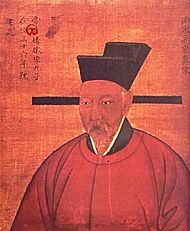
The new situation with the Southern Song, Jin, and Western Xia continued the time of division and conflict in China. The area between the Yangzi and Huai rivers became a new borderland and battlefield from 1128 to 1141. This forced hundreds of thousands of families to leave their homes. The Southern Song used several military commanders, like Yue Fei and Han Shizhong, to fight the Jin and retake land. They had some success. Yue Fei was even preparing to retake Kaifeng, the old Song capital.
However, the possible defeat of the Jurchens worried Emperor Gaozong and his chief minister, Qin Hui. This was because Emperor Qinzong of Song, the last Northern Song emperor, was living in exile in Manchuria. He might have been brought back to the throne if the Jin dynasty was destroyed. So, Yue Fei was ordered to return to the capital and stop his campaign. Emperor Gaozong signed the Treaty of Shaoxing in 1141. This treaty set the borders at the Huai River and gave up territory Yue Fei had won back. Yue Fei was later killed while imprisoned. As part of the treaty, the Song also had to pay tribute to the Jin, just like they had to the Liao. After this treaty, fighting between the Jin and Song stopped for 20 years. Emperor Gaozong also negotiated for his mother's release. She was eventually freed, but Qinzong was never released from the north.
Decades after Yue's death, Emperor Xiaozong of Song honored Yue Fei as a national hero in 1162. He was given a proper burial and a shrine. To shame those who had pushed for his execution, iron statues of Qin Hui and his wife were made to kneel before Yue Fei's tomb in Hangzhou.
As the great Indian Ocean naval power of the Chola dynasty in India declined, Chinese sailors increased their activity in Southeast Asia and the Indian Ocean. Even during the Northern Song period, the king of Srivijaya sent tribute to the Chinese court in 1028. In 1077, the Indian Chola ruler Kulothunga Chola I sent a trade group to Emperor Shenzong of Song's court and made good profits. Other regions also sent tribute. An Egyptian sea captain traveled to China in 1008 and gave gifts to Emperor Zhenzong of Song, starting diplomatic relations.
During the Northern Song, Quanzhou was a busy port visited by many foreigners, including Arabs, Persians, and Indians. Muslims from other countries controlled much of the import and export trade. In 1087, the Northern Song government created an office in Quanzhou to handle maritime affairs and trade. Quanzhou soon became a major trading center, rivaling Guangzhou. Other important seaports included Xiamen.

When the Song capital moved south to Hangzhou, many people came from the north. Southern China's mountains and rivers made widespread farming difficult. So, the Southern Song developed a strong maritime presence, unlike earlier dynasties. This was needed to get foreign resources. Coastal and river cities, supported by the state, greatly increased shipbuilding. They also improved harbors, built warehouses, and set up navigation beacons. Navigation at sea became easier with the invention of the compass. Shen Kuo also wrote about true north in the 11th century.
For military defense and economic reasons, the Southern Song created China's first standing navy. China had a long naval history, but the Southern Song court was the first to create a large, permanent naval force in 1132. The new headquarters was at Dinghai. As early as 1129, officials suggested conquering Korea with a new navy. This was meant to use Korea as a base to invade Jin territory. But defending the border with Jin was more important.
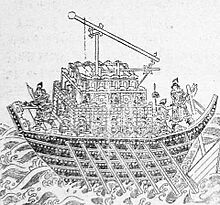
A Song writer, Zhang Yi, wrote in 1131 that China must see the Sea and the River as its Great Wall. He said warships should replace watchtowers. The Hangzhou government followed this idea. They successfully used their navy to defend against the hostile Jin to the north. Joseph Needham wrote that the Song navy grew from 11 squadrons and 3,000 men to 20 squadrons and 52,000 men in one century. Their main base was near Shanghai. In 1129, gunpowder bombs thrown by trebuchets became standard on warships. Between 1132 and 1183, many paddle-wheel ships were built, some with 11 paddle-wheels on each side. In 1203, some ships were armored with iron plates. The Southern Song navy held off the Jurchen Jin and then the Mongols for almost 200 years. They gained full control of the East China Sea.
During the reign of Emperor Xiaozong of Song, China increased trade missions to ports across the Indian Ocean. The Chinese sailed regularly to Korea and Japan in the Far East. They also sailed west to India, Sri Lanka, the Persian Gulf, and the Red Sea. The Chinese wanted to import goods like rare woods, precious metals, gems, spices, and ivory. They exported silk, ceramics, copper coins, and books. In 1178, a customs officer wrote about an island far west in the Indian Ocean (possibly Madagascar). He said people with "skin as black as lacquer" were captured and sold as slaves by Arab merchants. China was also shown on Islamic maps. In 1154, the geographer Al-Idrisi described Chinese ships carrying iron, swords, silk, and other goods. He praised the silk from Quanzhou as the best in the world. Hangzhou was known for glass wares. By the 13th century, the Chinese even knew the story of the ancient Lighthouse of Alexandria.
Defeating the Jin Invasion in 1161
In 1153, the Jin emperor Wanyan Liang moved his capital from Manchuria to Zhongdu (now Beijing). Four years later, in 1157, he destroyed Beijing and moved the Jin's southern capital to Kaifeng. He started a big rebuilding project there. For most of his rule, there was peace between Jin and Song. They had a steady flow of trade. The Jin dynasty imported large amounts of tea, rice, sugar, and books from the Southern Song. However, Wanyan Liang restarted the war with the Song in the 1160s.
Wanyan Liang launched a military campaign against the Southern Song in 1161. He had 70,000 naval troops on 600 warships. The Song fleet was much smaller, with only 120 warships and 3,000 men. At the Battle of Tangdao and the Battle of Caishi along the Yangtze River, Jin forces were defeated by the Southern Song navy. The Jin navy was wiped out by the smaller Song fleet. This was because the Song used fast paddle-wheel crafts and gunpowder bombs launched from trebuchet catapults. Meanwhile, two rebellions by Jurchen nobles and Khitan tribes broke out in Manchuria. This forced the Jin court to pull back its troops from southern China to stop these uprisings. In the end, Wanyan Liang failed to take the Southern Song and was killed by his own generals in December 1161. The Khitan uprising was stopped in 1164. The Treaty of Longxing was signed in 1165 between Song and Jin. It brought back the 1142 border and led to 40 years of peace.
Rise of the Mongols
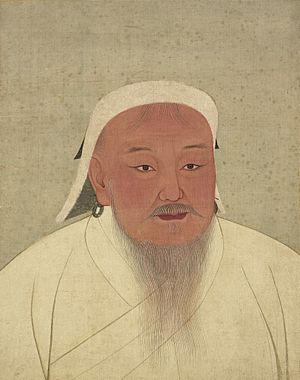
In 1205 and 1209, the Jin state was raided by Mongols from the north. In 1211, Genghis Khan launched a major campaign. His army had 50,000 archers, and his three sons led similar-sized armies. The Mongols increased their numbers by using Khitans and Han Chinese who were not loyal to the Jurchen rulers. After a Jurchen general killed the Jin emperor Wanyan Yongji in 1213, a peace deal was made between Jin and the Mongols in 1214. Genghis made the Jin a vassal state. However, when the Jin court moved from Beijing to Kaifeng, Genghis saw this as a rebellion. He attacked the old Jin capital at Beijing in 1215, burning it. The small Jin state tried to defend against the Mongols and even fought the Song in 1216 and 1223. But the Mongols attacked the Jin again in 1229. In 1232, the Jurchens fought bravely against the Mongols. They used 'thunder-crash-bombs' and fire lance flamethrowers. However, the capital at Kaifeng was captured in 1233. By 1234, the Jin dynasty finally fell to the Mongols after the capture of Caizhou.
The Western Xia faced a similar fate. They became unreliable to the Mongols by trying to ally with Jin and Song. Genghis Khan died in 1227 during the siege of their capital city. The last Xia ruler was killed when he was convinced to leave his city.
Mongol Invasion and End of the Song Dynasty
After the death of Gaozong and the rise of the Mongols, the Song dynasty allied with the Mongols. They hoped to finally defeat the Jin dynasty. The Song sent tens of thousands of carts of grain to the Mongol army during the siege. After the Jin dynasty was destroyed in 1234, the Southern Song generals broke the alliance. They tried to recapture the three old capitals of Kaifeng, Luoyang, and Chang'an. However, these cities were ruined by years of war and were hard to defend. Breaking the alliance meant open war between the Mongols and the Song dynasty. Ögedei Khan's forces conquered 54 of Sichuan's 58 districts by 1236. They ordered the killing of over a million people in Chengdu, which the Mongols easily took.
Möngke's Campaign
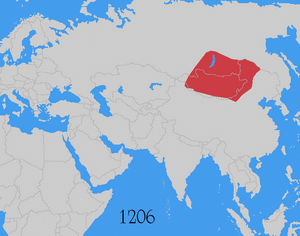
The Mongols eventually gained the upper hand under Möngke Khan. He was famous for his battles in Russia and Hungary. He also oversaw the final defeat of the Ch'oe family in Korea in 1258.
In 1252, Möngke sent his younger brother Kublai and the experienced general Uriyangkhadai to conquer the Dali Kingdom. From 1253 to 1254, they successfully conquered the tribes. Uriyangkhadai's military experience was very helpful. After Kublai returned to northern China, Uriyangkhadai conquered nearby tribes in Tibet. He then turned east towards the Trần dynasty by 1257.
Meanwhile, Uriyangkhadai's forces invaded Vietnam and captured the Trần dynasty capital of Thang Long in 1258. His forces stayed until 1259. In 1259, Uriyangkhadai's forces attacked Guangxi from Thang Long. This was part of a planned Mongol attack. Other Mongol armies attacked in Sichuan and in modern-day Shandong and Henan. Möngke Khan died during the Siege of Diaoyu Castle in Chongqing on August 11, 1259. There are different ideas about how he died, including an arrow wound, dysentery, or cholera.
Möngke's death led to the main Mongol armies being called back. This caused a fight over who would be the next Khan. This fight eventually favored Kublai.
A Changing Border
Even though Möngke's death paused the war, his younger brother Kublai continued fighting the Southern Song along the Yangzi River for two months in late 1259. Kublai bravely crossed the river during a storm and attacked the Southern Song troops. Both sides had many losses, but Kublai's troops won and gained a foothold south of the Yangzi. Kublai prepared to take the heavily fortified city of Ezhou. The Song chancellor Jia Sidao sent General Lü Wende to defend Ezhou. Lü managed to get past Kublai's forces and enter the city. Jia Sidao then sent an envoy to negotiate with Kublai. He offered Kublai yearly tribute, like the earlier treaty with the Khitans. In return, he asked for the territories south of the Yangzi that the Mongols had taken. Kublai rejected the offer because he was in a strong position. By late 1259, Uriyangkhadai's army fought its way north to meet Kublai's army. However, Kublai had to stop the war and travel north with most of his forces because of the Toluid Civil War with his brother Ariq Böke.
Chancellor Jia Sidao saw Kublai's absence as a chance to restart the war. The Song army defeated the small Mongol force south of the Yangzi and regained their lost territory. Kublai was busy fighting his brother, so he could not focus on the south. On May 21, 1260, Kublai sent his envoy Hao Jing to negotiate with the Southern Song. But Jia Sidao ordered Kublai's embassy to be held. Kublai did not forget this insult. From 1260 to 1262, Song forces raided Kublai's southern border. Kublai responded with small attacks until 1264, when his brother finally surrendered. In 1265, the first major battle in five years happened in Sichuan province. Kublai won and captured 146 Song naval ships.
Growing Discontent

While Kublai was busy in the north, the Song court prepared for war. They gathered all available resources. In the mid-13th century, the Song government, led by Jia Sidao, started taking parts of rich people's estates. This was to raise money for the war. This made wealthy landowners unhappy. They preferred the Mongol conquest to paying higher taxes for endless war.
There was also growing political opposition against Chancellor Jia Sidao. Jia had removed several officials who opposed his reforms. He replaced them with his own friends. This created divisions at court and among the wealthy class. These divisions made it easier for Kublai to gain support. Kublai used different ways to attract people from the Southern Song to his side. He made Dadu (Beijing) his new capital in 1264. He pleased the Chinese by naming his dynasty "Yuan," which means "primal" in Chinese. He gave land, clothes, and oxen to Song Chinese who joined him. Kublai released Song captives and prisoners. Jia Sidao, however, refused to release Kublai's envoy. In 1261, Kublai released 75 Song merchants. In 1263, he released 57 merchants. In 1269, he released 45 merchants. In 1264, he publicly criticized his own officers for executing two Song generals without trial. These actions greatly improved his reputation among the Chinese.
Battle of Xiangyang
The siege of Xiangyang was a long conflict from 1268 to 1273. Xiangyang and the nearby town of Fancheng were the last fortified places in Kublai's way to the rich Yangzi River basin. Kublai tried to starve the city by blocking its supply lines. He gained control of the Han River with a huge blockade. A Song defector, Liu Zheng, advised Kublai Khan to build up the Yuan's navy, which helped them greatly. An international force of Chinese, Jurchens, Koreans, Mongols, Uyghur Turks, and Middle Eastern Muslims helped Kublai build ships and artillery. The Southern Song tried to break the Yuan blockade several times, but each attempt failed, costing thousands of men and hundreds of ships. After the siege, in 1273, Kublai appointed the Chinese general Shi Tianze and the Turkic general Bayan as commanders of the armed forces. Shi Tianze died in 1275. Bayan was then given 200,000 soldiers, mostly Han Chinese, to attack the Song.
Final Resistance
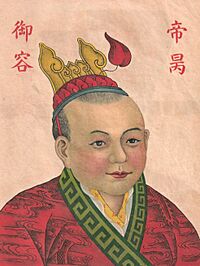
In March 1275, Bayan's forces faced Chancellor Jia Sidao's army of 130,000. Bayan won a decisive victory, and Jia was forced to retreat after many of his soldiers left him. His political rivals took this chance to remove him. Jia was stripped of his rank and sent into exile. On his way, he was killed. After his death, many of his supporters joined Bayan. By 1276, the Yuan army had conquered almost all of the Southern Song's territory, including the capital at Hangzhou.
Meanwhile, the remaining Song court fled to Fuzhou. Emperor Gong of Song was left behind as the empress dowager surrendered to Bayan. She was horrified by reports of the complete destruction of Changzhou. Before the capital was taken, Empress Dowager Xie (1208–1282) tried to negotiate with Bayan, promising yearly tribute to the Yuan dynasty. But he refused. After her diplomacy failed, she gave the Song dynasty's imperial seal to Bayan, showing their surrender. Bayan ordered that the Song imperial family be respected. He forbade looting their tombs or treasuries. Kublai gave the deposed emperor the title "Duke of Ying." But he was later sent to Tibet, where he became a monk in 1296.
Any hope of resistance rested on two young princes, Emperor Gong's brothers. The older boy, Zhao Shi, who was nine, was declared emperor on June 14, 1276, in Fuzhou. The court sought safety in Quanzhou, hoping for an alliance with the Muslim Superintendent of Maritime Shipping, Pu Shougeng. However, he secretly allied with Kublai, so the Song court had to flee in 1277. Pu switched sides after Song general Zhang Shijie seized his ships when Pu refused to lend them for the war. The court then sought refuge on Lantau Island. The older brother became ill and died on May 8, 1278, at age 10. He was succeeded by his younger brother, who became Emperor Huaizong of Song, aged seven. The Sung Wong Toi monument in Kowloon remembers his enthronement. On March 19, 1279, the Song army was defeated in its last battle, the Battle of Yamen. This battle was fought against the Yuan army led by the Han general Zhang Hongfan in the Pearl River Delta. Song Prime Minister Lu Xiufu died with the boy emperor in his arms.
With the death of the last emperor, the Song dynasty ended. Kublai Khan established the Yuan dynasty over China, Mongolia, Manchuria, Tibet, and Korea. The Yuan dynasty lasted until 1368, when it was overthrown by the Ming dynasty.
Han Shantong, a leader of the Red Turban Rebellions in 1351, claimed to be a descendant of Emperor Huizong of Song. His son Han Lin'er was declared emperor of a restored Song dynasty in 1355.
Towards the end of the Yuan dynasty, the Yuan Mongols turned against Pu Shougeng's family and the Muslims. They killed many of Pu Shougeng's descendants in the Ispah rebellion. Mosques and other foreign buildings were almost all destroyed.
Historical Writings
During the Song dynasty, a huge work of Chinese history called the Zizhi Tongjian was written. It means "Comprehensive Mirror for/to Aid in Government." Emperor Yingzong of Song ordered it in 1065. A team of scholars led by Sima Guang finished it in 1084. It had 294 volumes and about 3 million Chinese characters. The Zizhi Tongjian covers Chinese history from 403 BC until the start of the Song dynasty in 959. Its size and detail are often compared to the famous work of the ancient historian Sima Qian, called the Shiji. This historical work was later shortened into 59 different books by the Neo-Confucian philosopher Zhu Xi in 1189.
Another historical source was the huge encyclopedia Prime Tortoise of the Record Bureau, published by 1013. It was one of the Four Great Books of Song. This book had 1000 volumes and 9.4 million Chinese characters. It provided important information on political writings, biographies of rulers, and many official letters and decrees sent to the imperial court. However, the official history of the Song dynasty was the Song Shi, written in 1345 during the Yuan dynasty. The history of the Jurchen Jin dynasty, the Jin Shi, was written in the same year.
|
See also
 In Spanish: Historia de la dinastía Song para niños
In Spanish: Historia de la dinastía Song para niños
- Chinese literature
- History of China
- Military history of China (pre-1911)
- Naval history of China
- Timeline of the Jin–Song Wars
- Wen Tianxiang
- Yang Hui
- Zhou Tong (archer)




